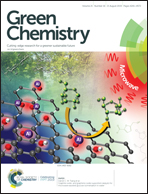Altered carbon assimilation and cellulose accessibility to maximize bioethanol yield under low-cost biomass processing in corn brittle stalk†
Abstract
Although cellulosic ethanol has been regarded as an ideal additive for transportation fuels, its low accessibility from recalcitrant lignocellulose renders the bioethanol process unacceptably expensive for commercial production. Here, this study collected the brittle stalk of a corn mutant, bk1, that showed similar biomass and seed yields to its wild type (elite cultivar). We then detected significantly reduced cellulose content and degree of polymerization of β-1,4-glucans, leading to a 74% increase in directly-fermentable hexoses accumulation in the brittle stalk by reducing sucrose production and altering carbon assimilation. Notably, under two green-like pretreatments (20 min liquid hot water, 15% CaO at 50 °C), the brittle stalk exhibited remarkably improved cellulose accessibility for almost complete biomass saccharification. This resulted in achieving the highest bioethanol yield of 19.3% (% dry matter) to date, outperforming previous efforts that relied on harsh corn stalk pretreatments. Furthermore, even without any pretreatment, we evaluated that the brittle stalk could deliver a bioethanol yield of 20.3% if the total xylose and hexoses from the brittle stalk were combined for yeast co-fermentation. This study has thus provided a prospective new model for the green-like bioethanol industry that integrates engineered bioenergy crops and yeast strains with cost-effective biomass processing.



 Please wait while we load your content...
Please wait while we load your content...